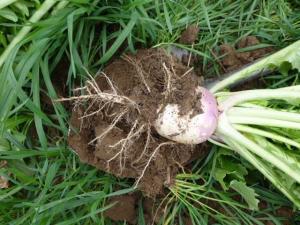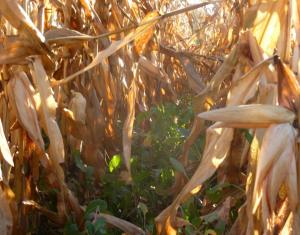Cover crops can improve soil health, erosion control, and provide wildlife forage. Choosing wildlife friendly cover crops can attract and hold wildlife on your property from fall to early spring, while providing multiple benefits to your cropping system. If participating in a program, follow specific programmatic requirements.
Definition
A wildlife friendly cover crop is an annual or perennial planting of grasses, non-legume broad-leaves, and/or legumes to provide food and/or cover for a variety of wildlife on agricultural land in conjunction with or after cash crops.
Benefits
- Habitat diversity.
- Pollinator habitat.
- Mixes that include turnip, radish, or sugar beets provide food, first as leaf, then as an edible bulb.
- Can relieve wildlife pressure on commercial crops.
- Many mixes can be planted in late spring to fall.
- Shorter period to maturity and need less rain than a corn food plot.
- Fewer inputs than a conventional food plot.
- They improve soil organic matter.
- Improved infiltration.
- Great for erosion control.
Uses of Wildlife Friendly Cover Crops
A wildlife friendly cover crop adds plant diversity, food, and cover to the landscape as well as being agronomically sound for erosion control or other purposes related to conservation or soil improvement. It can also be considered where land is planned to provide a winter or early spring food source for wildlife.
Seeding Guidance (pdf)
Aerial - Typically done into standing crops.
Drill - Typically done after crop is harvested or in a split row or narrow row cropping system.
Broadcast - Can be used in standing or harvested crops.
Seeding Dates
Seeding dates are especially critical to allow for adequate growth to provide the intended benefit.
Prior to Harvest
If seeding prior to harvest (prior to leaf drop and/or near crop maturity), broadcast seed using a method allowing good coverage and for fewer damages to the standing crop. These methods would include seeding by air, high clearance applicator, or when split applying fertilizer. Cover crops broadcast seeded into standing corn should be done between V4-V6. Seedbed preparation is not necessary. When broadcast seeding prior to harvest it is important to have good soil moisture near the surface.
After Harvest
If seeding after harvest, seed may be either no-till planted or broadcast seeded into existing residue cover. Aerial application can be used if soils are saturated. Immediately incorporate if the seed is broadcast on a prepared seedbed to ensure good seed-to-soil contact. Some producers mix seed in the fertilizer application to reduce the number of trips over the field.
Wildlife Friendly Mixes
Example Mix 1: 30% Annual Ryegrass, 20% Crimson Clover, 20% Oilseed Radish, 20% Turnip, 10% Dwarf Essex Rape
Drilled Seeding Rate: 10 lb/acre
Planting Depth: 1/2 inch
Aerial & Broadcast Seeding Rate: 15 lb/acre
Approximate Planting Date: June 10 - 20, August 15 - September 15
Example Mix 2: 30% Oilseed Radish, 20% Annual Ryegrass, 15% Common Vetch, 15% Crimson Clover, 15% Lentil, 5% Sunn Hemp
Drilled Seeding Rate: 17 lb/acre
Planting Depth: 3/4 inch
Aerial & Broadcast Seeding Rate: 25 lb/acre
Approximate Planting Date: June 10 - 20, August 15 - September 15



